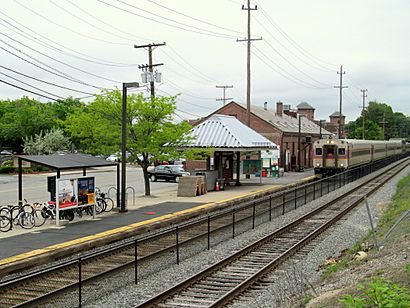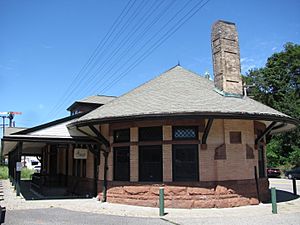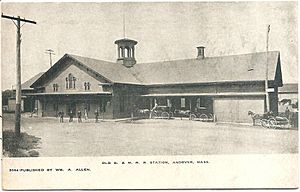Andover station (MBTA) facts for kids
Quick facts for kids
Andover
|
|||||||||||
|---|---|---|---|---|---|---|---|---|---|---|---|

An inbound train arrives at Andover station in 2017
|
|||||||||||
| Location | 17 Railroad Street, Andover, Massachusetts | ||||||||||
| Coordinates | 42°39′28″N 71°08′41″W / 42.6579°N 71.1446°W | ||||||||||
| Owned by | MBTA | ||||||||||
| Line(s) | Western Route | ||||||||||
| Platforms | 1 side platform | ||||||||||
| Tracks | 2 | ||||||||||
| Connections | |||||||||||
| Construction | |||||||||||
| Parking | 150 spaces ($4.00 daily) 4 accessible spaces |
||||||||||
| Bicycle facilities | 6 spaces | ||||||||||
| Disabled access | Yes | ||||||||||
| Other information | |||||||||||
| Fare zone | 5 | ||||||||||
| Traffic | |||||||||||
| Passengers (2018) | 409 (weekday average boardings) | ||||||||||
| Services | |||||||||||
|
|||||||||||
|
Third Railroad Station
|
|||||||||||

The third railroad station in Andover
|
|||||||||||
| Location | 100 School Street, Andover, Massachusetts | ||||||||||
| Area | 9 acres (3.6 ha) | ||||||||||
| Built | 1906-07 | ||||||||||
| Architectural style | Shingle Style | ||||||||||
| MPS | Town of Andover MRA | ||||||||||
| NRHP reference No. | 82004809 | ||||||||||
| Added to NRHP | June 10, 1982 | ||||||||||
Andover station is a train station in Andover, Massachusetts. It is part of the MBTA Commuter Rail system. This station serves the Haverhill Line, which connects towns to Boston.
The station has one platform for passengers. This platform also has a special mini-high section. This part helps people using wheelchairs or with other mobility needs get on and off the train easily. There is a second track, but it does not have a platform for passengers.
The old station building, which was used from 1907 to 1959, is still standing today. It was added to the National Register of Historic Places in 1982. It is known as the Third Railroad Station.
Contents
History of Andover Station
Early Train Lines in Andover
The first train line in this area was the Andover and Wilmington Railroad. It started running trains in August 1836. This line was a smaller branch of the new Boston and Lowell Railroad.
A small wooden station was built near the center of Andover. The train line soon grew longer, heading north. In 1842, it became part of the Boston and Maine Railroad (B&M).
Moving the Main Train Line
After building its own route to Boston in 1845, the B&M wanted more passengers. They wanted to compete with the Boston and Lowell Railroad. In 1848, the B&M moved its main line. It shifted from Ballardvale to North Andover, going west. This change helped the trains serve the new mill town of Lawrence.
The train line in Andover was also moved. It shifted a few blocks west, away from the busy town square. At first, a small house was used as a temporary station. Soon, a larger L-shaped station was built. This new station even had a big roof over the tracks, called a train shed. A brick building for carrying goods, called a freight house, was also built around this time.
Building a New Station in 1906
By 1906, people were complaining about the smoky air inside the train shed. So, the B&M company started building a brand new station. This new station looked like another station called Beverly Depot. It was designed by an architect named Bradford Lee Gilbert.
The new Andover station opened on September 1, 1907. It was used as the main station until 1959. Later, in 1982, this building was added to the National Register of Historic Places. It is officially known as the Third Railroad Station.
Changes to Train Service
In November 1974, the towns of North Andover and Andover decided not to pay for train service anymore. Train service to North Andover station stopped on November 15.
However, people and businesses in Andover quickly raised money. They wanted to keep the train service going until April 1975. On April 7, 1975, the town residents voted to pay back the commuters. They also voted to pay for train service for another year.
After that year, the town decided not to pay for service anymore. So, the three train stops in Andover were closed. These stops were Shawsheen, Andover, and [[{{{station}}} (MBTA station)|{{{station}}}]]. This happened on April 2, 1976. The full train trip, which then only stopped at Lawrence, Bradford, and Haverhill, ended in June 1976.
Service Resumes and Modern Updates
The MBTA, which runs public transportation, bought all the train equipment and lines from the B&M. This happened on December 27, 1976. This included the Western Route, which goes from Wilmington Junction to the New Hampshire border.
Train service to Haverhill, including the stop at Andover, started again on December 17, 1979. Around 1992, a special mini-high platform was added. This made the station more accessible for everyone.
Today, MBTA passengers get on the train from a single platform. This platform is located behind the old freight house. Both the old station building and the old freight house are now used for businesses.




